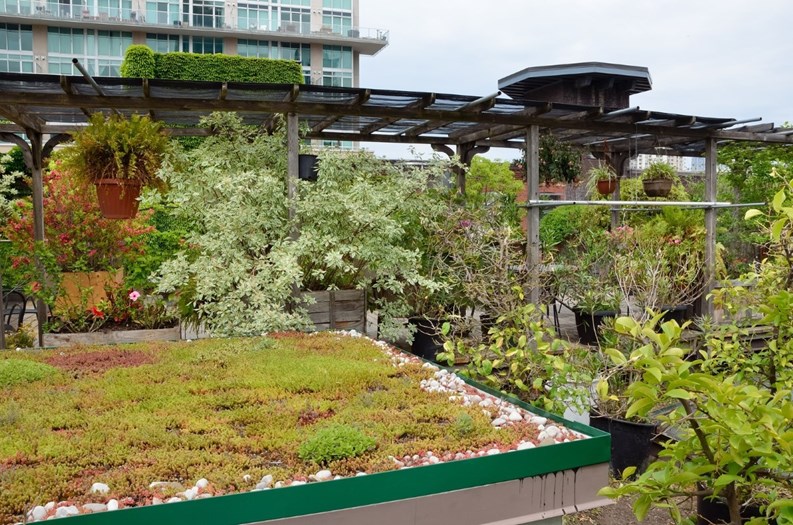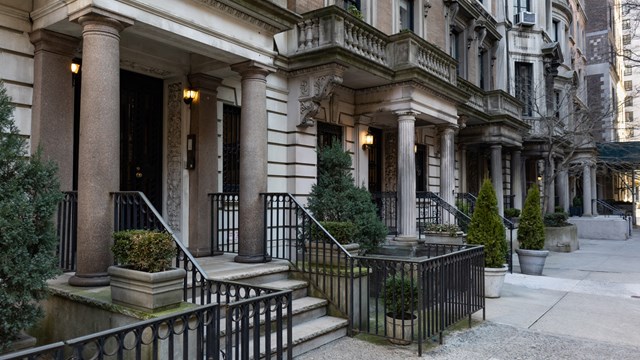In a city known for its expanses of steel and concrete, despite that giant expanse of parkland at its center, it can be easy to forget the importance that greenery plays in the life of New Yorkers. For many co-op and condo residents, the flowers, shrubs, grasses and trees that surround their buildings, fill their courtyards and spill gently from their balconies soften the edges of urban living and bring colorful life to a sometimes monochromatic landscape.
The selection, planting and care of those oases of green can be a significant undertaking, one that requires a solid understanding of what plants and flowers will thrive in an urban environment and avoiding those that simply will not.
“At times, plants can be selected with emotion (i.e., I like the way a plant looks) rather than with practicality which takes into consideration the site conditions and environmental conditions such as light, weather, water and foot traffic,” said Victoria Shapiro of Blondie’s Treehouse Inc., in an email interview. “The public space of the city can be a harsh environment for plants,” says Shapiro, whose company located in Mamaroneck provides landscaping and plant care services to the metro New York area.
Some of those dangers include air pollution, trampling, storm water run-off, pets burrowing and relieving themselves in or near the plantings. This winter’s massive snows may pose another problem for plants this coming spring as well. “A lot of buildings will use rock salt and not the environmentally safe salt,” says Iris Kaplow, the president of New York City-based Iris Kaplow Landscapes. That salt can kill greenery.
Kaplow and Shapiro both agree that a lack of maintenance can also leave urban plants vulnerable. In a hectic world, it is easy for building staff to forget the plants or flowers until they begin to wilt or show signs of sickness. And by then it might be too late to save them. Before planting, it’s important to know “water requirements and have building personnel who can meet that challenge,” says David Protell of Chelsea Garden Center Inc., in New York. “Some plants need watering twice a day. Others can handle more arid conditions. Building personnel need to know what they’re doing.” Without that proper plan of care, even the most well designed garden can suffer.
On the Rooftop?
With space at a minimum in “The Big Apple” one must take into consideration the structure where the plants will live. Many use the roof to create their urban oasis. Once it's decided to create that garden on the roof, building a solid foundation is key.
According to Wiggins Lindor, sales director at Sitecraft Company, a division of The Rosenwach Group, he urges that in terms of construction, wood is much lighter than concrete and it is more flexible in terms of design.
“With wood you have a lot more options with how to install it [the garden] versus concrete. You have more alternatives with wood, it is easy to carry and install,” Lindor says.
In addition to using wood and concrete as the foundation of the garden, many residential buildings are also using recycled plastics as a roof deck material. “The benefit using the recycled plastic is that it is maintenance-free. You don't have to seal it or sand it. Once you put it down, it’s lifetime-free maintenance, all you have to do is power-wash it,” adds Lindor.
Starting Out on the Right Foot
With careful planning, though, a great many of those vulnerabilities can be avoided. For example, “one of the main things is having the correct hardiness zone,” says Kaplow. “New York is usually a six or seven but if you bought a plant that’s hearty in zones eight, nine or 10, it won’t be hearty here because those are West Coast zones. The right plant for the right environment is really key.”
The first step is deciding where flora will be planted because environment will play a big role when it comes to choosing the right plants for the right spaces. “Start with the architecture of the building and its overall aesthetic,” says Kaplow. “Pick things that complement that style while contrasting nicely with the building materials and keeping the integrity of design that the builders had in mind. Plant design can soften a space by incorporating organic elements.”
There is also a matter of what purpose the plants are serving. “Sometimes boards have a distinct idea of what they want,” says Kaplow. “Always ask the board. Do they want formal or informal gardens? How do they want the plants to function—as shocks of color, to hide security lighting, to provide privacy for ground units?”
Thankfully for urban landscapers, there are a number of plants that flourish in the New York environment. For trees to be planted adjacent to a sidewalk or in lawn sites in the public right of way, the city has an approved species list, found on the New York City Department of Parks and Recreation’s website. The list is extensive, ensuring a wide variety of options for residential buildings. “Some of the more interesting varieties (on the list) include Kentucky Coffee Tree, white oaks, Japanese Zelkova and European Hornbeam,” says Shapiro.
“For the understory, a reliable curbside garden might incorporate such plant material as Otto Luyken laurel, boxwoods, ilex, yews, ivy, carex, begonia, coleus, caladium, lantana, lysimachia and ipomoea,” says Shapiro. For more private gardens or communal spaces, away from high-traffic areas, “a wider range of plant material may be utilized based on the site conditions and the owner’s aesthetic values,” she says.
Kaplow suggests using plants in the evergreen group that usually do well, such as “boxwood, junipers, yews, pines and some hollies. You could do some grasses, too. You want some things that are hearty annuals.” There is also, she says, “a big trend to use native plants.”
Protell agrees that “boxwoods in any shape or form as well as the taxus yew and ilex” are good choices. The ilex is boxwood-like in appearance and is good for topiaries. In shady areas, “laurels are good,” Protell says, both the spreading variety, which is the Otto Luyken, and the upright version called Skip Laurel, which produces white flowers in the spring.
Plants to Avoid
Just as certain greenery will thrive in an urban setting, others have the cards stacked against them from the get-go. In general, these include those plants “with a fragile structure or that require high maintenance, such as roses,” says Shapiro.
Kaplow adds, “They have to be able to withstand urban pollution and you want to have average plant maintenance. Plants that need to be pruned or those that are high maintenance” might not be the best matches, depending on the resources of the building and its staff. Other common sense factors include ensuring that light requirements are met. “Something that needs a lot of light wouldn’t do well in low light,” Kaplow says. “Certain plants are just heartier than others.”
Plants lacking in resiliency will not do well in the high-traffic streets of New Yor City. “They need to hold up to animals and the environment,” says Protell. “There’s no protection for trampling feet other than wickets or tree guards” for those plants in tree wells. “Without those, it’s a recipe for losing your flowers.”
Vehicles can be another hazard for plant life. “For curbside plantings, the biggest issue is that any planters need to be protected from being knocked into by trucks. For portable planters at the curbside, you need to be cognizant of the sturdiness and resiliency of the plant.
Flora for an Extra Eye-Catching Splash
Certain plants can help tell a story by underscoring a building’s personality or the face it wants to put forward to potential residents. Figuring out how to go about that “is a great conversation to have with your landscape company,” says Shapiro. “They will be able to select the best plant material suited for the site conditions while considering your aesthetic values.”
And those aesthetic values and interests can vary enormously. For plantings, says Protell, you “can go from vanilla to Ben and Jerry’s. All co-ops and condos have their own flavors” and personalities. A commercial building in Midtown, for example, may want to put a more conservative face on their greenery than a new residential building in Park Slope.
Protell cites one design that his firm did that began with geraniums and evolved into an array of tropical plantings. “Twenty thousand people come in and out of that building every day and they’re blown away.” Tropical plantings such as these can include ferns, caladiums in the shade, hibiscus, certain palms and exotic tropical evergreens. When it comes to designs these days, “it doesn’t have to be your mother’s geraniums,” Protell says.
The way the plants are presented is also key to making an impression. “For instance, instead of things being laid out in static rows, you may plant using sweeping lines and build layer and texture depending on the relationships of the different plants in the garden,” says Shapiro.
Maintain Your Greenery
One of the most important factors in ensuring a healthy green space is maintenance, something that should be considered before the first bulb or seed of grass is planted. “Plantings are much more likely to thrive with a reliable maintenance program which typically includes irrigation, hand-watering, pruning, weeding, litter removal and pest control,” says Shapiro. “With routine monitoring, you can be sure to take care of any needs that arise and make sure your gardens are always looking their best.”
It is wise to create that maintenance program when first signing on with a landscaper or beginning the landscape design process. “Certain buildings will have budgets for maintenance,” says Kaplow. “They usually hire for installation and maintenance. You’ll usually have foundation plantings and that maintenance is built in.” The costs all depend on the size of the green space, from planters and tree pits to courtyards, as well as the types of trees, flowers and shrubs incorporated into the design.
Pruning also should be crucial part of any maintenance program, says Kaplow. “Proper pruning is important. It looks good and it helps growth. You don’t want branches overlapping each other or rubbing against each other,” which can cause cuts and open them up to disease. “Prune correctly so it grows correctly. There’s a real science to it.”
And there is a real science to choosing the best, heartiest and most eye-catching trees, shrubs and flowers to accent and enhance any residential space. With the right experts and an understanding of all the work, energy and yes, love, needed to keep these fragile flora healthy, there’s no limit to the beauty that can add to any building.
Elizabeth Lent is a freelance writer and a frequent contributor to The Cooperator.







Leave a Comment